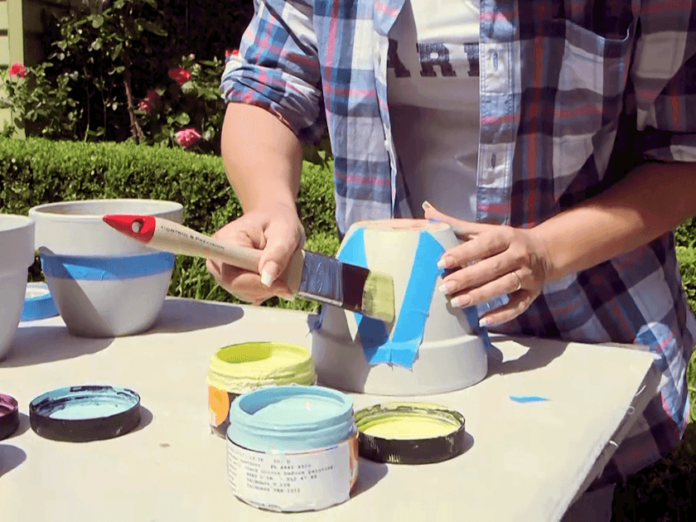[ad_1]
It’s all well and good to invest in the best paint, but a painting project can easily come undone without the right tools and accessories to aid the process.
Here, we look at three DIY painting projects you can tacking in the home — and the different tools they each need.
1. Paint your pots
Freshening up old pots and planters is a fairly no-fuss job. Depending on the old pot you’re working with, you may need some fine sandpaper to smooth over the surface and a damp cloth to wipe it down, but then you’re good to go.

When it comes to brushes, you’ll want a small brush (less than 50mm) or roller (around 100mm). Because you’re working with a small object and surface area, you want a brush that fits just right.
“Brushes around 25-35mm hold less paint, giving you much better control for painting,” professional painter Mark O’Connor says. “This makes jobs easier and quicker.”
If you’re wanting to paint patterns or particularly small details, you may also want a range of painters paint brushes.
For paint, you’ll want a good outdoor, water-resistant paint in the colour of your choosing. Then get yourself a good quality, small-ish paint brush (less than 50mm).
After that, you’re ready to paint.

Note, depending on the porosity of your pot, you may need to do multiple coats. A more porous material, like stone or terracotta, will require more coats to achieve the right coverage. Just don’t lather it on too thick in one coat.
What you’ll need:
- Sandpaper
- Painters tape, if you’re painting the pot in different sections or patterns
- A damp cloth to clean the surface
- A quality exterior paint
- A small brush, such as a Monarch Walls, Doors and Trims brush
- A paint tin or tray
2. Paint a room
When painting your room, before doing anything else, clear as many items as you can out of the space and protect whatever remains with old sheets, tarps and drop cloths. Also, don’t forget to tape everything you don’t want paint on, from lights to windows, electrical sockets and so on.

When it comes to paint tools, you’ll need a range of rollers and brushes. Firstly, you’ll need a small brush to ‘cut in’, i.e. paint along any edges or trims and in corners. Then, you’ll need a roller frame and a roller of around 230-270mm.
Remember, the type of brush is one matter, the other key factor is quality.
“The best quality paint needs to be applied using the best quality paint accessories,” Mark advises.
“Many DIY-ers, once they see the price of paint, underestimate the importance of quality accessories. They purchase budget brushes and rollers, which make it extremely difficult to achieve the finish they are looking for.
“If you want to attempt to achieve a professional finish without paying for a painter, then choose products that painters would be happy to use.”
Mark also urges you to stir your paint before starting.
“Even if you just got your paint mixed when you purchased it, give it another stir for three to five minutes to make sure the colour has been stirred properly right through the whole can,” he says. “This will ensure that your paint is the colour it should be.”
Finally, don’t forget to do multiple coats and let the previous job dry completely before venturing the next one!

What you’ll need:
- A quality matt interior paint in your desired colour and finish
- A small, cutting-in brush, such as Monarch Cutting In & Framing Brush (in 50mm, 63mm or 75mm width) or the Monarch Walls, Doors and Trims brush (also in 63mm or 50mm width)
- A large paint roller, such as Monarch Expertech Professional Wall & Ceiling roller (in either 180mm, 230mm or 270mm width), or the Monarch Microfibre Wall & Ceiling roller (again in 180mm, 230mm or 270mm width).
- A roller pole and/or handheld roller
- A paint tray
- Drop sheets and/or tarps
- Painters tape
- A cloth and sugar soap
- A wooden stick to stir the paint before using
3. Paint your furniture
Painting your furniture will require similar tools to other small projects, like your pots.
The process is also similar, depending on the finish of the furniture. If you’re painting over varnished timber, you’ll need to thoroughly sand back the varnish before starting your job. You may even choose to use a power sander, depending on the size of your item. If you want a smooth finish, you’ll then want to do a primer and sealer undercoat to help smooth the surface.

When it comes to paint tools, a job like this will depend on the size of your furniture. Most projects will require a brush for small surfaces, such as chairs or table legs. If the object is much bigger, like a large wardrobe or table top, you can move to a roller.
When painting, just remember not to overload your brush with paint.
“You should never load your brush with paint all the way up the filament to the metal ferrule,” Mark reminds.
“Painters only load the bottom third to half of the brush. Any paint further up the brush will only dry out. To load your brush, remember to have only an inch of paint in your paint pot.
“Dip your brush in the paint, then don’t wipe off the excess paint on the rim of the pot. Simply ‘tap’ the brush several times on the side of the can. This will take off the excess and give you a properly loaded brush ready to paint.”
If applying stains or varnishes rather than paint, use one of the Monarch Woodcare brushes, Mark adds.
“They are specifically designed for applying either water based or oil based stains and varnishes.”
What you’ll need:
- Small brush, such as a Monarch Walls, Doors and Trims brush or a Monarch Woodcare brush for varnish
- A roller and roller frame, such as the Monarch Smartlock Mini Rollers (in 180mm or 230mm depending on the size of the furniture)
- A gloss or semi gloss paint, or your desired varnish
- An undercoat primer
- A paint tray or bucket
- Painters tape
- Sandpaper and/or a power sander
- A cloth and sugar soap
Tips for caring for and storing your paint brushes
Regardless of the paint job you’re doing, Mark reminds us to always use and store our brushes and rollers correctly.
He advises that brushes and rollers must be kept moist while painting so they don’t dry out. So, don’t leave them out of the paint for too long!
“When you take a break, stand your brush in the paint pot, which should only half about an inch of paint in it,” Mark begins. “This will keep the brush wet. For the roller, load it with paint, sit it on the grill of the tray, not swimming in the bottom of the tray immersed in paint. Simply cover the tray with a couple of sheets of aluminium foil.”
Mark adds, if your paint job takes more than a day, you don’t need to wash your brushes at the end of day one.
“You don’t have to wash out your brushes and rollers every night if you haven’t finished painting. If you are going to paint again next day, simply load the brush and roller with paint to help keep them moist, then wrap them thoroughly in some cling wrap.”
All uncredited images supplied by Monarch.
The post 3 easy painting projects and the tools you’ll need appeared first on realestate.com.au.
[ad_2]
www.realestate.com.au










